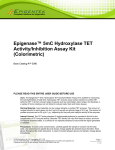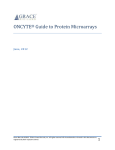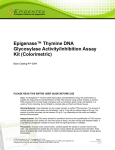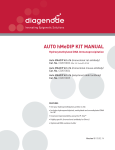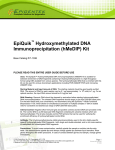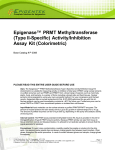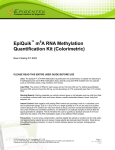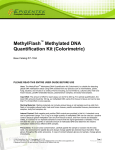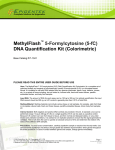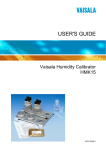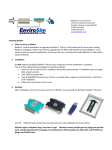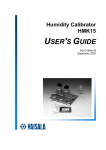Download EpiQuik™ DNA Demethylase Activity/ Inhibition Assay Ultra Kit
Transcript
EPIGENTEK Complete Solutions for Epigenetics EpiQuik™ DNA Demethylase Activity/ Inhibition Assay Ultra Kit Base Catalog # P-3008 PLEASE READ THIS ENTIRE USER GUIDE BEFORE USE Uses: The EpiQuik™ DNA Demethylase Activity/Inhibition Assay Ultra Kit is suitable for measuring total DNA demethylase activity/inhibition using nuclear extracts from a broad range of species such as mammals and plants, in a variety of forms including, but not limited to, cultured cells and fresh tissues. Starting Materials: The amount of nuclear extracts for each assay can be 2 µg to 20 µg with an optimal range of 5-10 µg. Internal Control: An assay standard is provided in this kit for the quantification of DNA demethylase activity. Because DNA demethylase activity can vary from tissue to tissue, and from normal and diseased states, it is advised to run replicate samples to ensure that the signal generated is validated. Precautions: To avoid cross-contamination, carefully pipette the sample or solution into the strip wells. Use aerosol-barrier pipette tips and always change pipette tips between liquid transfers. Wear gloves throughout the entire procedure. In case of contact between gloves and sample, change gloves immediately. 110 Bi County Blvd. Ste. 122, Farmingdale, NY 11735 Tel: 1-877-374-4368 ■ Fax: 1-718-484-3956 ■ E-mail: [email protected] ■ Web: www.epigentek.com © Epigentek Group Inc. All rights reserved. Products are for research use only. Page 1 Printed 2014-09-22 P-3008 EPIGENTEK Complete Solutions for Epigenetics KIT CONTENTS Component 48 Assays Cat. #P-3008-48 96 Assays Cat. #P-3008-96 Storage Upon Receipt WB (10X Wash Buffer) 14 ml 28 ml 4°C DAB (Demethylase Assay Buffer) 3 ml 6 ml RT AS (10X Assay Substrate)* 10 µl 20 µl –20°C BS (Binding Solution) 5 ml 10 ml RT ACS (Assay Control Standard, 20 µg/ml)* 10 µl 20 µl –20°C CA (Capture Antibody,1000 µg/ml)* 4 µl 8 µl 4°C DA (Detection Antibody, 400 µg/ml)* 6 µl 12 µl –20°C ES (Enhancer Solution)* 6 µl 12 µl –20°C DS (Developer Solution) 5 ml 10 ml 4°C SS (Stop Solution) 5 ml 10 ml RT 8-Well Assay Strips (With Frame) 6 12 4°C User Guide 1 1 RT * For maximum recovery of the products, centrifuge the original vial prior to opening the cap. SHIPPING & STORAGE The kit is shipped in two parts: the first part at ambient room temperature, and the second parts on frozen ice packs at 4°C. Upon receipt: (1) Store AS, ACS, DA, and ES at –20°C away from light; (2) Store WB, CA, DS, and 8-Well Assay Strips at 4°C away from light; (3) Store remaining components (DAB, BS and SS) at room temperature away from light. Note: Check if WB 10X Wash Buffer contains salt precipitates before use. If so, warm at room temperature or 37°C and shake the buffer until the salts are re-dissolved. All components of the kit are stable for 6 months from the date of shipment, when stored properly. MATERIALS REQUIRED BUT NOT SUPPLIED Adjustable pipette or multiple-channel pipette Multiple-channel pipette reservoirs Aerosol resistant pipette tips Microplate reader capable of reading absorbance at 450 nm 1.5 ml microcentrifuge tubes Incubator for 37°C incubation Distilled water Nuclear extract 110 Bi County Blvd. Ste. 122, Farmingdale, NY 11735 Tel: 1-877-374-4368 ■ Fax: 1-718-484-3956 ■ E-mail: [email protected] ■ Web: www.epigentek.com © Epigentek Group Inc. All rights reserved. Products are for research use only. Page 2 Printed 2014-09-22 P-3008 EPIGENTEK Complete Solutions for Epigenetics Parafilm M or aluminum foil GENERAL PRODUCT INFORMATION Quality Control: Each lot of the EpiQuik™ DNA Demethylase Activity/Inhibition Assay Ultra Kit is tested against predetermined specifications to ensure consistent product quality. Epigentek guarantees the performance of all products in the manner described in our product instructions. Product Warranty: If this product does not meet your expectations, simply contact our technical support unit or your regional distributor. We also encourage you to contact us if you have any suggestions about product performance or new applications and techniques. Safety: Suitable lab coat, disposable gloves, and proper eye protection are required when working with this product. Product Updates: Epigentek reserves the right to change or modify any product to enhance its performance and design. The information in this User Guide is subject to change at any time without notice. Thus, only use the User Guide that was supplied with the kit when using that kit. Usage Limitation: The EpiQuik™ DNA Demethylase Activity/Inhibition Assay Ultra Kit is for research use only and is not intended for diagnostic or therapeutic application Intellectual Property: EpiQuik™ DNA Demethylase Activity/Inhibition Assay Ultra Kit and methods of use contain proprietary technologies by Epigentek. A BRIEF OVERVIEW DNA demethylation is necessary for the epigenentic reprogramming of genes and is also directly involved in many important disease mechanisms such as tumor progression. Demethylation of DNA can either be passive or active, or a combination of both. Passive DNA demethylation usually takes place on newly synthesized DNA strands via DNMT1 during replication rounds. Active DNA demethylation mainly occurs by the removal of 5-methylcytosine through further modified cytosine bases which have been converted by TET enzyme-mediated oxidation. These oxidation products have been shown to be repaired by TDG, a glycosylase which is involved in base excision repair, or directly converted to cytosine by DNMT3A/ DNMT3B in oxidative states. It is proposed that DNA demethylation could also be initiated by deamination of 5-mC through candidate deaminases including AID and APOBEC1, which convert 5-mC to thymine. The resulting thymine could be repaired by BER initiated by a T-G mismatch glycosylase such as MBD4 or TDG. In addition, the 5-mC base can be directly removed in plants by the DME/ROS1 family of 5-mC DNA glycosylases, resulting in an abasic site that is repaired by the BER process. 110 Bi County Blvd. Ste. 122, Farmingdale, NY 11735 Tel: 1-877-374-4368 ■ Fax: 1-718-484-3956 ■ E-mail: [email protected] ■ Web: www.epigentek.com © Epigentek Group Inc. All rights reserved. Products are for research use only. Page 3 Printed 2014-09-22 P-3008 EPIGENTEK Complete Solutions for Epigenetics DNA demethylation mechanisms involving various DNA demethylase (Chen ZX et al : J. Biol. Chem., 286:18347-18353, 2011) Currently, there are very few methods available for the detection of DNA demethylase activity/inhibition using nuclear extracts. The original EpiQuik™ DNA Demethylase Activity/Inhibition Assay Kit addressed this issue by introducing a simple method with an ELISA-like 96-well plate format. This newer EpiQuik™ DNA Demethylase Activity/Inhibition Assay Ultra Kit (Colorimetric) is a further refinement of its predecessor kit by enhancing sample signals and significantly minimizing background signals, in addition to being five times more sensitive. Colorimetric assay with easy-to-follow steps for convenience and speed. The entire procedure can be completed within 4 hours. Safe and innovative colorimetric assay without radioactivity, extraction, or chromatography. An ultra-sensitive detection limit with as low as 1 µg of nuclear extract, which is five times more sensitive than the predecessor kit. 96 strip-well microplate format allows for either low or high throughput analysis. PRINCIPLE & PROCEDURE 110 Bi County Blvd. Ste. 122, Farmingdale, NY 11735 Tel: 1-877-374-4368 ■ Fax: 1-718-484-3956 ■ E-mail: [email protected] ■ Web: www.epigentek.com © Epigentek Group Inc. All rights reserved. Products are for research use only. Page 4 Printed 2014-09-22 P-3008 EPIGENTEK Complete Solutions for Epigenetics The EpiQuik™ DNA Demethylase Activity/Inhibition Assay Ultra Kit is designed for measuring total DNA demethylase activity/inhibition. In an assay with this kit, the unique methylated DNA substrate is stably captured on the strip wells. Active DNA demethylases bind to and demethylate the DNA substrate. The methylated DNA can be recognized with a high affinity 5-methylcytosine antibody and the immuno-signal is enhanced with enhancer solution. The ratio or amount of methylated DNA, which is inversely proportional to enzyme activity, can then be colorimetrically quantified through an ELISAlike reaction. 1 R2 = 0.9743 0.9 0.8 OD 450nm 0.7 0.6 0.5 0.4 0.3 0.2 0.1 0 0 1 2 3 4 5 Assay Control Standard (ng) Assay control standard was added into the assay wells at different concentrations and then measured with the DNA Demethylase Activity/Inhibition Assay Ultra Kit. Schematic procedure of the EpiQuik™ DNA Demethylase Activity/Inhibition Assay Ultra Kit. 110 Bi County Blvd. Ste. 122, Farmingdale, NY 11735 Tel: 1-877-374-4368 ■ Fax: 1-718-484-3956 ■ E-mail: [email protected] ■ Web: www.epigentek.com © Epigentek Group Inc. All rights reserved. Products are for research use only. Page 5 Printed 2014-09-22 P-3008 EPIGENTEK Complete Solutions for Epigenetics ASSAY PROTOCOL For the best results, please read the protocol in its entirety prior to starting your experiment. Starting Materials Input Amount: The amount of nuclear extracts for each assay can be 2 µg to 20 µg with an optimal range of 5-10 µg. Nuclear Extraction: You can use your method of choice for preparing nuclear extracts. Epigentek offers a nuclear extraction kit (Cat # OP-0002) optimized for use with this kit. Nuclear Extract Storage: Nuclear extract should be stored in aliquots at –80°C until use. 1. Buffer Solution & Preparation a. Prepare Diluted WB 1X Wash Buffer: 48-Assay Kit: Add 13 ml of WB 10X Wash Buffer to 117 ml of distilled water and adjust pH to 7.2-7.5. 96-Assay Kit: Add 26 ml of WB 10X Wash Buffer to 234 ml of distilled water and adjust pH to 7.2-7.5. This Diluted WB 1X Wash Buffer can now be stored at 4°C for up to six months. b. Prepare 1X AS Assay Substrate: Add 1 µl of AS 10X Assay Substrate to 9 µl of DAB Demethylase Assay Buffer. About 2 µl of 1X AS will be required for each assay well. c. Prepare Diluted CA Capture Antibody Solution: Dilute CA Capture Antibody with Diluted WB 1X Wash Buffer at a ratio of 1:1000 (i.e., add 1 µl of CA to 1000 µl of Diluted WB 1X Wash Buffer). About 50 µl of Diluted CA will be required for each assay well. d. Prepare Diluted DA Detection Antibody Solution: Dilute DA Detection Antibody with Diluted WB 1X Wash Buffer at a ratio of 1:2000 (i.e., add 1 µl of DA to 2000 µl of Diluted WB 1X Wash Buffer). About 50 µl of Diluted DA will be required for each assay well. e. Prepare Diluted ES Enhancer Solution: Dilute ES Enhancer Solution with Diluted WB 1X Wash Buffer at a ratio of 1:5000 (i.e., add 1 µl of ES to 5000 µl of WB 1X Wash Buffer). About 50 µl of Diluted ES will be required for each assay well. f. Prepare Diluted ACS Standard Solution: Suggested Standard Curve Preparation: First, dilute ACS with DAB to 5 ng/µl by adding 1 µl of ACS to 4 µl of DAB. Then, further prepare five concentrations by combining the 5 ng/µl Diluted DAS with DAB into final concentrations of 0.2, 0.5, 1.0, 2.0 and 5.0 ng/µl according to the following dilution chart: 110 Bi County Blvd. Ste. 122, Farmingdale, NY 11735 Tel: 1-877-374-4368 ■ Fax: 1-718-484-3956 ■ E-mail: [email protected] ■ Web: www.epigentek.com © Epigentek Group Inc. All rights reserved. Products are for research use only. Page 6 Printed 2014-09-22 P-3008 EPIGENTEK Complete Solutions for Epigenetics DAB Resulting ACS Concentration Tube ACS (5 ng/µl) 1 1.0 µl 24.0 µl 0.2 ng/µl 2 1.0 µl 9.0 µl 0.5 ng/µl 3 1.0 µl 4.0 µl 1.0 ng/µl 4 2.0 µl 3.0 µl 2.0 ng/µl 5 4.0 µl 0.0 µl 5.0 ng/µl Note: Keep each of diluted solutions except Diluted WB 1X Wash Buffer on ice until use. Any remaining diluted solutions other than Diluted WB should be discarded if not used within the same day. 2. Enzymatic Reaction a. Predetermine the number of strip wells required for your experiment. Carefully remove un-needed strip wells from the plate frame and place them back in the bag (seal the bag tightly and store at 4°C). b. Add 80 µl of BS Binding Solution to each well. c. Add 2 µl of 1X AS into each sample well. Add 2 µl of DAB into blank wells. Add 1 µl of Diluted ACS into the standard curve wells (see the designated wells depicted in Table 2 under the “Suggested Strip Well Setup” section). Mix solution by gently tilting from side to side or shaking the plate several times. Ensure the solution coats the bottom of the well evenly. Note: For the standard curve, add 1 µl of Diluted ACS at concentrations of 0.2 to 5 ng/µl (see the chart in Step 1g). The final concentrations should be 0.2, 0.5, 1, 2 and 5 ng per well. d. Cover strip plate with plate seal or Parafilm M and incubate at 37°C for 90 min. e. Remove the reaction solution from each well. f. Wash each well three times with 150 µl of the Diluted WB 1X Wash Buffer each time. g. Blank Wells: Add 50 µl of DAB to each blank well. h. Standard Wells: Add 50 µl of DAB to each standard well i. Control Sample Wells without Nuclear Extracts: Add 45-48 µl of DAB and 2-5 µl of your protein extraction buffer. j. Sample Wells Without Inhibitor: Add 46 to 49 µl of DAB and 1 to 4 µl of nuclear extracts to each sample well without inhibitor. Total volume should be 50 µl per well. k. Sample Wells With Inhibitor: Add 41 to 44 µl of DAB, 1 to 4 µl of nuclear extracts and 5 µl of inhibitor solution. Total volume should be 50 µl per well. Note: (1) Follow the suggested well setup diagrams under “Suggested Strip Well Setup”; (2) It is recommended to use 5 µg to 10 µg of nuclear extract per well;(3) The concentration of inhibitor to be added into the sample wells can be varied (1 µM to 1000 µM). However, the final concentration of the inhibitors before adding to the wells should be prepared with DAB at a 1:10 ratio (i.e., add 0.5 µl of 110 Bi County Blvd. Ste. 122, Farmingdale, NY 11735 Tel: 1-877-374-4368 ■ Fax: 1-718-484-3956 ■ E-mail: [email protected] ■ Web: www.epigentek.com © Epigentek Group Inc. All rights reserved. Products are for research use only. Page 7 Printed 2014-09-22 P-3008 EPIGENTEK Complete Solutions for Epigenetics inhibitor to 4.5 µl of DAB) so that the original solvent of the inhibitor can be reduced to 1% of the reaction solution or less. l. Tightly cover strip plate with Parafilm M to avoid evaporation and incubate at 37°C for 60-90 min. m. Remove the reaction solution from each well. Wash each well three times with 150 µl of the Diluted WB 1X Wash Buffer each time. 3. Antibody Binding & Signal Enhancing a. Add 50 µl of the Diluted CA to each well, then cover with Parafilm M or aluminum foil and incubate at room temperature for 60 min. b. Remove the Diluted CA solution from each well. c. Wash each well three times with 150 µl of the Diluted WB 1X Wash Buffer each time. d. Add 50 µl of the Diluted DA to each well, then cover with Parafilm M or aluminum foil and incubate at room temperature for 30 min. e. Remove the Diluted DA solution from each well. f. Wash each well four times with 150 µl of the Diluted WB 1X Wash Buffer each time. g. Add 50 µl of the Diluted ES to each well, then cover with Parafilm M or aluminum foil and incubate at room temperature for 30 min. h. Remove the Diluted ES from each well. i. Wash each well five times with 150 µl of the Diluted WB 1X Wash Buffer each time. Note: Ensure any residual wash buffer in the wells is thoroughly removed at each wash step. The wash can be carried out by simply pipetting the wash buffer into the wells and then pipetting the buffer out from the wells (discard the buffer). 4. Signal Detection a. Add 100 µl of DS to each well and incubate at room temperature for 1 to 10 min away from light. Begin monitoring color changes in the sample wells and control wells. The DS solution will turn blue in the presence of sufficient methylated DNA. b. Add 100 µl of SS to each well to stop enzyme reaction when the color in the positive control wells turns medium blue. The color will change to yellow after adding SS and the absorbance should be read on a microplate reader within 2 to 10 min at 450 nm with an optional reference wavelength of 655 nm. Note: (1) Most microplate readers have capability to carry out dual wavelength analysis and will automatically subtract reference wavelength absorbance from the test wavelength absorbance. If your plate reader does not have this capability, the plate can be read twice – once at 450 nm and once at 655 nm. Then manually subtract the 655 nm ODs from 450 nm ODs; (2) If the stripwell microplate frame does not fit in the microplate reader, transfer the solution to a standard 96-well microplate. 5. DNA Demethylase Activity Calculation a. Calculate the average duplicate readings for sample wells and blank wells. 110 Bi County Blvd. Ste. 122, Farmingdale, NY 11735 Tel: 1-877-374-4368 ■ Fax: 1-718-484-3956 ■ E-mail: [email protected] ■ Web: www.epigentek.com © Epigentek Group Inc. All rights reserved. Products are for research use only. Page 8 Printed 2014-09-22 P-3008 EPIGENTEK Complete Solutions for Epigenetics b. Calculate Total DNA demethylase activity or inhibition using the following formulas: For simple calculation: Demethylase activity (OD/h/mg) = [OD (control# – blank) – OD (sample – blank)] [Protein Amount (µg)/1000 ]* X Hour ** # Sample wells without Nuclear Extracts * Protein amount added into the reaction at step 2j ** Incubation time at step 2L. Example calculation: Average OD450 of Control is 0.55 Average OD450 of sample is 0.25 Average OD450 of blank is 0.05 Protein amount is 5 µg Incubation time is 1 hour (0.5 – 0.2) DNA demethylase activity = (5/1000 x 1) = 60 OD/h/mg For accurate or specific activity calculation: First, generate a standard curve and plot the OD values versus the amount of ACS at each concentration point. Then determine the slope as OD/ng using linear regression (Microsoft Excel’s linear regression or slope functions are suitable for such calculation) and the most linear part (include at least 4 concentration points) of the standard curve for optimal slope calculation. Now calculate DNA demethylase activity using the following formula: [OD (control# – blank) – OD (sample – blank)] Activity (ng/h/mg) = × 1000 Slope × Protein Amount (µg)* X Hour ** # Sample wells without nuclear extracts * Protein amount added into the reaction at step 2j ** Incubation time at step 2L. For inhibition calculation: Inhibition % = (1− [OD (control – blank) – OD (inhibitor sample – blank)] ) × 100% [OD (control – blank) – OD (no inhibitor sample – blank)] 110 Bi County Blvd. Ste. 122, Farmingdale, NY 11735 Tel: 1-877-374-4368 ■ Fax: 1-718-484-3956 ■ E-mail: [email protected] ■ Web: www.epigentek.com © Epigentek Group Inc. All rights reserved. Products are for research use only. Page 9 Printed 2014-09-22 P-3008 EPIGENTEK Complete Solutions for Epigenetics SUGGESTED STRIP WELL SETUP Table 1. Approximate amount of required buffers and solutions for defined assay wells based on the protocol. Reagents 1 well 1 strip (8 wells) 2 strips (16 wells) 6 strips (48 wells) 12 strips (96 wells) Diluted WB 2.5 ml 20 ml 40 ml 120 ml 240 ml DAB 50 µl 400 µl 800 µl 2400 µl 4800 µl 1 X AS 2 µl 16 µl 32 µl 96 µl 192 µl ACS N/A N/A 4 µl (optional) 8 µl 8 µl BS 80 µl 650 µl 1350 µl 2700 µl 5400 µl Diluted CA 50 µl 400 µl 800 µl 2400 µl 4800 µl Diluted DA 50 µl 400 µl 800 µl 2400 µl 4800 µl Diluted ES 50 µl 400 µl 800 µl 2400 µl 4800 µl DS 0.1 ml 0.8 ml 1.6 ml 4.8 ml 9.6 ml SS 0.1 ml 0.8 ml 1.6 ml 4.8 ml 9.6 ml Table 2. The suggested strip-well plate setup for standard curve preparation in a 48-assay format (in a 96-assay format, Strips 7 to 12 can be configured as Sample). The controls and samples can be measured in duplicate. Well # A B C D E F G H Strip 1 Blank ACS 0.2 ng/µl ACS 0.5 ng/µl ACS 1 ng/µl ACS 2 ng/µl ACS 5 ng/µl Sample Sample Strip 2 Blank ACS 0.2 ng/µl ACS 0.5 ng/µl ACS 1 ng/µl ACS 2 ng/µl ACS 5 ng/µl Sample Sample Strip 3 Sample Sample Sample Sample Sample Sample Sample Sample Strip 4 Sample Sample Sample Sample Sample Sample Sample Sample 110 Bi County Blvd. Ste. 122, Farmingdale, NY 11735 Tel: 1-877-374-4368 ■ Fax: 1-718-484-3956 ■ E-mail: [email protected] ■ Web: www.epigentek.com © Epigentek Group Inc. All rights reserved. Products are for research use only. Strip 5 Sample Sample Sample Sample Sample Sample Sample Sample Strip 6 Sample Sample Sample Sample Sample Sample Sample Sample Page 10 Printed 2014-09-22 P-3008 EPIGENTEK Complete Solutions for Epigenetics TROUBLESHOOTING Problem Possible Cause Suggestion No signal or weak signal in both the standard and sample wells Reagents are added incorrectly. Check if reagents are added in the proper order with the right amount, and if any steps in the protocol may have been omitted by mistake. The substrate and standard are not properly bound to the wells. Ensure that (1) the DAB and ACS are added into the wells; (2) the wells are completely covered with sufficient BS Binding Solution; and (3) binding time is sufficient (90 min). Incubation time and temperature are incorrect. Ensure the incubation time and temperature described in the protocol are followed correctly. Incorrect absorbance reading. Check if the appropriate absorbance wavelength (450 nm filter) is used. Kit was not stored or handled properly. Ensure all components of the kit were stored at the appropriate temperatures and the cap is tightly capped after each opening or use. The standard amount is insufficiently added to the well in Step 2c. Ensure a sufficient amount of standard is added. The standard is degraded due to improper storage conditions. Follow the Shipping & Storage guidance of this User Guide for storage of ACS (Assay Control Standard). Insufficient washing of wells. Check if washing at each step is performed according to the protocol. Contaminated by sample or standard. Ensure the well is not contaminated from adding sample or standard accidentally or from using contaminated tips. Incubation time with detection antibody is too long. The incubation time at Step 3d should not exceed 45 minutes. Over development of color. Decrease the development time in Step 4a before adding SS Stop Solution in Step 4b. Protein sample is not properly extracted or purified. Ensure your protocol is suitable for DNA demethylase extraction. For the best results, it is advised to use Epigentek’s Nuclear Extraction Kit (Cat. No. OP-0002). Also, use fresh No signal or weak signal in only the standard curve wells High background present in the blank wells No signal or weak signal only in sample wells 110 Bi County Blvd. Ste. 122, Farmingdale, NY 11735 Tel: 1-877-374-4368 ■ Fax: 1-718-484-3956 ■ E-mail: [email protected] ■ Web: www.epigentek.com © Epigentek Group Inc. All rights reserved. Products are for research use only. Page 11 Printed 2014-09-22 P-3008 EPIGENTEK Complete Solutions for Epigenetics cells or tissues for protein extraction, as frozen cells or tissues could lose enzyme activity. Uneven color development Sample amount added into the wells is insufficient. Ensure a sufficient amount of nuclear extracts is used as indicated in Steps 2j and 2k. The sample can be titrated to determine the optimal amount to use in the assay. Sample was not stored properly or has been stored for too long. Ensure sample is stored in aliquots at –80°C, with no more than 6 weeks for nuclear extracts. Avoid repeated freezing/thawing. Little or no activity of DNA demethylase contained in the sample. This problem may be a result of many factors. If the affecting factors cannot be determined, use new or reprepared nuclear extracts. Insufficient washing of the wells. Ensure the wells are washed according to the user guide. Ensure residual wash buffer is removed as much as possible. Delayed color development or delayed stopping of color development in the wells. Ensure color development and stop solutions are added sequentially and consistent with the order you added the other reagents (e.g., from well A to G or from well 1 to 12). RELATED PRODUCTS Nuclear Extract Preparation OP-0002-1 EpiQuik™ Nuclear Extraction Kit DNA Hydroxymethylation P-1036 MethylFlash™ Hydroxymethylated DNA Quantification Kit (Colorimetric) P-1037 MethylFlash™ Hydroxymethylated DNA Quantification Kit (Fluorometric) P-1038 EpiQuik™ Hydroxymethylated DNA Immunoprecipitation (hMeDIP) Kit P-3087 Epigenase™ 5mC-Hydroxylase TET Activity/Inhibition Kit (Fluorometric) 110 Bi County Blvd. Ste. 122, Farmingdale, NY 11735 Tel: 1-877-374-4368 ■ Fax: 1-718-484-3956 ■ E-mail: [email protected] ■ Web: www.epigentek.com © Epigentek Group Inc. All rights reserved. Products are for research use only. Page 12 Printed 2014-09-22 P-3008












